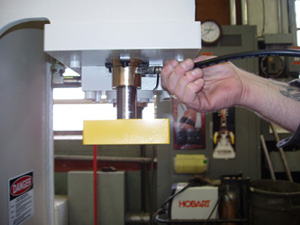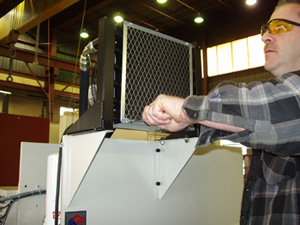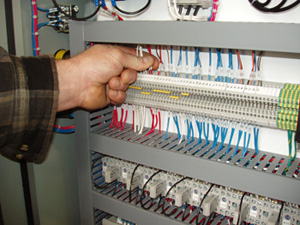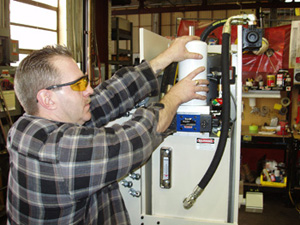| |
 |
|

Search Hydraulic Presses By:
Search Arbor Presses By:
|
|
 |
|

|
| Mar 27, 2007 | | KNOW THY PRESS: IN SICKNESS & IN HEALTH | How to keep hydraulic presses running.
 By Mr. Thomas Lavoie, Applications Manager at Greenerd Press & Machine Company, Inc. and Mr. Carl Jean, Service Manager at Greenerd Press & Machine Company, Inc.
By Mr. Thomas Lavoie, Applications Manager at Greenerd Press & Machine Company, Inc. and Mr. Carl Jean, Service Manager at Greenerd Press & Machine Company, Inc.
An apple a day may keep the doctor away, but what should press operators do to keep their hydraulic presses in proper working order? By knowing when a hydraulic press is running well or is in need of attention, performing regular maintenance steps and recognizing when to replace a press, manufacturers can extend a presses’ life and maximize their investment.
To understand when a hydraulic press is performing as it should, press operators can check on several factors to be sure all is well. Healthy traits for a hydraulic press include a press that runs cool. A press should not be running above 150 degrees.
Hydraulic presses that are in good working condition have no leaks and will get up to pressure quickly. For instance, it is a good sign if it is taking .5 to 1 second to build to the maximum required pressure. If it takes over 2-3 seconds, a problem with a pump, valve or motor may be indicated. Typically pressure problems are pump related. However, in some occasions the relief valve may be working slowly. Perhaps dirt or grit is in the line or the valve is too far open. Also, if the press’s motor is not producing sufficient RPMs, a drop in pressure could occur.
 Users should be tuned into various processes on their hydraulic presses to ensure good operations. For example, the valve shifts should be smooth from one speed change to the next - operators should not hear any banging noises during speed changes. In fact, any strange sounds that are not considered normal should be investigated promptly.
Users should be tuned into various processes on their hydraulic presses to ensure good operations. For example, the valve shifts should be smooth from one speed change to the next - operators should not hear any banging noises during speed changes. In fact, any strange sounds that are not considered normal should be investigated promptly.
Mr. Thomas Lavoie, Applications Manager at Greenerd Press & Machine Company, says, “Quite simply, we recommend that operators keep their eyes and ears tuned to the press.”
Also, it is critical that press operators continually check for loose wires and fittings or any frayed hoses. Operators should also look for leaking seals around the RAM. If any of these defects are found, proper operation of the press can be affected. While checking seals etc. they should also be sure that sufficient lubrication is applied wherever necessary.
Check It Out: Daily Preventative Measures
To help create a system for these type of observations and what should be checked on daily basis, Mr. Carl Jean, Service Manager at Greenerd Press & Machine Company, has developed a daily maintenance checklist.
- Check for oil leaks. All hydraulic lines should be checked because a very small leak can turn into a very big mess. Any loose fitting should be tightened and wiped clean of the spilled oil. Keeping a press clean will assist operators in locating any new leaks that might develop.
- Check the oil’s fluid level. If necessary, top it off. To determine the type of oil to be used, refer to an oil tag that is affixed to most machines.
- Check for loose bolts. Look around the tooling area because some die’s can cause vibration and shock that can loosen bolts.
- Check lubrication on guided platens. Some bushings will have fittings that should be greased to keep a small film of lubrication over the rod. Avoid over greasing because it will allow dirt to accumulate and cause the bearing to wear prematurely. Other bushings will have a check valve type fitting. These bushings have graphite impregnated into the bronze. These bushings require very little maintenance. The use of Mobil Viscolite or similar is best, but only a small amount is needed to spread the graphite onto the rod, coating the rod black and somewhat dry. Never put grease into this type of bearing.
- After the machine has had time to warm to operating temperature check the oil temperature (ideal temperature is 120 degrees F.)
- Check the press ram to ensure the ram is moist but not dripping oil.
- If applicable, check the light curtains. Simply break the beam while the Ram is traveling down and the press should stop immediately. Breaking the beam on the upstroke may not stop the press - always refer to the owner’s manual for proper function.
- Check to be sure work area is clean.
Key Maintenance Issues: Oil & Electrical
Jean suggests that keeping a press’s oil in new condition is a relatively simple task for extending the life of a press. Low oil levels and / or dirty oil will reduce the life of a press rapidly. Dirt and heat are common culprits.

Ideal operation temperature is about 120 degrees F. Oil temperature can be maintained by either air or water coolers. Probes are inserted into the oil reservoir and temperature maintained by the use of a thermostat. The air coolers use a radiator to separate the heat with the use of an electric fan moving the air through the cooler. The radiator should be kept clean, as they tend to collect dirt and dust in the vanes and prevent the airflow from traveling at maximum capacity. Attaching a common filter such as the ones used for heating and air conditioning to the heat exchanger will help keep the unit clean and is very inexpensive.
Water coolers work similarly except that water travels through the vanes. The method for the water could be city water, chillers or roof top mounted exchangers. Running city water through an exchanger could be expensive and will have a tendency to rust the inside of the exchanger. Also, many municipalities discourage the use of city water depending on local water restrictions and codes. Inspection should be done yearly. Roof top mounted units tend to collect dust and dirt, this can result in clogging of the exchanger and could also cause rusting. Again, inspect this equipment yearly. Placing a filter in line will help remove any fine particles. Water Chillers are the best means of heat dissipation because the inlet temperature can be adjusted and anti-rusting agents can also be added to the water. Jean suggests a yearly inspection just the same.
The next step in good oil maintenance is oil sampling. This should be done at least yearly and the results can tell operators when you need to change filters. From this sample users can tell how many particles of different sizes are in the oil, if the oil has water in it, as well as the lubricity properties. In most cases it is not necessary to change oil but certain additives may be needed. From the oil sampling it can be determined if the oil filters are being changed at proper intervals. Operators can also tell from the results if the correct micron level of filtration is being used. Simple hydraulic systems only require code 10 filters, which result in a cleanliness level of 20/18/15. More complex systems that have proportional or servo valves require code 03 filters, which have a cleanliness level of 16/14/12. There are numerous companies that can perform this test and maintain the records.
 However reliable, electronics present another critical area to be maintained. Coils that are located on valves normally have a life cycle of three million strokes. Relays normally have a life cycle of one million strokes. Replacing them before they fail can eliminate or reduce hours of troubleshooting and provide less down time. Installing an hour meter and non re-settable cycle counter will help to maintain accurate records and can help with scheduling maintenance. Control wiring should be checked annually to make sure all connections are tight and that the wiring is in good condition. Lose wiring should be placed in wire ways or tied with wire ties. All spares or unused wires should be capped off or removed. Any dust or dirt should be removed from enclosures.
However reliable, electronics present another critical area to be maintained. Coils that are located on valves normally have a life cycle of three million strokes. Relays normally have a life cycle of one million strokes. Replacing them before they fail can eliminate or reduce hours of troubleshooting and provide less down time. Installing an hour meter and non re-settable cycle counter will help to maintain accurate records and can help with scheduling maintenance. Control wiring should be checked annually to make sure all connections are tight and that the wiring is in good condition. Lose wiring should be placed in wire ways or tied with wire ties. All spares or unused wires should be capped off or removed. Any dust or dirt should be removed from enclosures.
Jean encourages all press operators to come up with a checklist – daily, monthly, and annual, that is relevant for all the equipment in their shops. This is critical for detecting issues early on and avoiding potentially expensive fixes later.
In With the New …
Knowing “when to say when” and making a decision to replace a press is also key for ensuring part production is accurate and consistent. Despite following good maintenance practices that will undoubtedly prolong the life of a hydraulic press, sometimes there are some signs which may indicate a replacement is in order.
Lavoie points out that there are several critical indicators that may signal that a new press is in order including:
-
The press can no longer build up pressure. Key areas to look into are the pump, press motor, and valves. However, if the pump is found to be faulty, press life may be able to be extended by replacing the pump.
- Cracks are found in the frame. These fractures can be subtle or obvious. A temporary fix is to possibly weld the frame, but ultimately the press will need to be replaced.
- Critical hydraulic or electrical problems.
If press operators ignore any of these warning signs and run the press while it is compromised, several performance sacrifices may also occur. When dealing with a pressure delay, cycle times will be increased. Downtimes will also be on the rise with faulty presses. Additionally, it is very possible that part accuracy will be adversely effected because varying pressure can cause inconsistently formed parts or parts that may not even be able to be punched out.
Lavoie recalls a customer who ran into a significant pressure problem on their press. “A customer was running parts on a press with irregular results. The bearing outside diameter was oversized and sleeve inside diameter was undersized and so the bearing could not be seated properly on some assemblies. Upon reviewing the problem, we ran the parts on a new Greenerd press with consistent results. This helped us to determine that the press the customer was using was not achieving the same pressure from stoke to stroke.”
In all, there are several preventative maintenance steps that can be performed to provide a hydraulic press with the longest life possible. Press operators who stay in tune with their press and establish good, consistent maintenance practices from the beginning, will benefit the most.
- END -
Mr. Lavoie has been with Greenerd for 11 years. He has spent the past 11 years in various positions at Greenerd with Applications Engineering being his specialty.
Mr. Jean has been with Greenerd for 23 years. He spent 20 years building and supervising the build of all of Greenerds presses. For the last three years he has served as Service Manager at Greenerd. Carl is an expert on the subject of presses and how to maintain and build them for longevity.
Greenerd Press & Machine Company, Inc.
www.greenerd.com
41 Crown St., P.O. Box 886
Nashua, NH 03031
Ph. (603) 889-4101
Fax (603) 889-7601
|
|
|
|

















 By Mr. Thomas Lavoie, Applications Manager at Greenerd Press & Machine Company, Inc. and Mr. Carl Jean, Service Manager at Greenerd Press & Machine Company, Inc.
By Mr. Thomas Lavoie, Applications Manager at Greenerd Press & Machine Company, Inc. and Mr. Carl Jean, Service Manager at Greenerd Press & Machine Company, Inc.  Users should be tuned into various processes on their hydraulic presses to ensure good operations. For example, the valve shifts should be smooth from one speed change to the next - operators should not hear any banging noises during speed changes. In fact, any strange sounds that are not considered normal should be investigated promptly.
Users should be tuned into various processes on their hydraulic presses to ensure good operations. For example, the valve shifts should be smooth from one speed change to the next - operators should not hear any banging noises during speed changes. In fact, any strange sounds that are not considered normal should be investigated promptly. 
 However reliable, electronics present another critical area to be maintained. Coils that are located on valves normally have a life cycle of three million strokes. Relays normally have a life cycle of one million strokes. Replacing them before they fail can eliminate or reduce hours of troubleshooting and provide less down time. Installing an hour meter and non re-settable cycle counter will help to maintain accurate records and can help with scheduling maintenance. Control wiring should be checked annually to make sure all connections are tight and that the wiring is in good condition. Lose wiring should be placed in wire ways or tied with wire ties. All spares or unused wires should be capped off or removed. Any dust or dirt should be removed from enclosures.
However reliable, electronics present another critical area to be maintained. Coils that are located on valves normally have a life cycle of three million strokes. Relays normally have a life cycle of one million strokes. Replacing them before they fail can eliminate or reduce hours of troubleshooting and provide less down time. Installing an hour meter and non re-settable cycle counter will help to maintain accurate records and can help with scheduling maintenance. Control wiring should be checked annually to make sure all connections are tight and that the wiring is in good condition. Lose wiring should be placed in wire ways or tied with wire ties. All spares or unused wires should be capped off or removed. Any dust or dirt should be removed from enclosures.